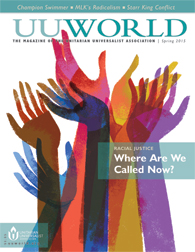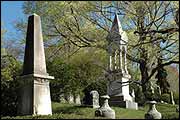America's first cemetery, Unitarian-style
Boston's 175-year-old Mount Auburn Cemetery reflects Unitarian views of death.
With the liberalization of Puritan New England and the rise of Unitarianism in the early nineteenth century came a need for a new kind of final resting place. In 1831, Bostonians—led by two Unitarians, physician Jacob Bigelow and U.S. Supreme Court Justice Joseph Story—founded the nonprofit Mount Auburn Cemetery on a 74-acre farm in Watertown, four miles outside the city. The nation's first "rural" or "garden" cemetery, it was first to use the term cemetery, from the Greek koimeterion for "place of sleep," rather than burial ground. Mount Auburn is celebrating its 175th anniversary with a yearlong calendar of lectures, walks, and other events.
The early Unitarian view of death and commemoration is reflected in the cemetery's design: set in a natural country landscape, with trees and flowers, paths and ponds, hills and dells, a place where the living can come for reflection and to honor their loved ones. In contrast with the Calvinist idea of a terrible final reckoning, early Unitarians saw death as a natural life passage to be welcomed as a reunion with Nature—"to mix forever with the elements," as William Cullen Bryant penned in his popular poem on death, Thanatopsis.
The change in perspective is exemplified by this story in Silent City on a Hill, a history of the cemetery: Looking into an opened grave in Boston's Old Granary Burial Ground, Col. Joseph May (Louisa May Alcott's grandfather) reacted in wonder rather than horror to the roots of an elm tree winding through the coffin and skull of a Revolutionary War leader. Turning his glance to a nearby "noble elm," May saw "in transfigured glory . . . all that was material of James Otis."
The idea of garden cemeteries, where both the living and the dead could mingle with nature, quickly caught on. Within fifteen years, nine other cities had founded their own, and the movement spread throughout the country.
Mount Auburn Cemetery became as essential a tourist destination as Niagara Falls. It also inspired the creation of public parks and art museums. Early town commons had always been strictly functional, for grazing animals and drilling the militia, while art collections were almost always in private estates. Mount Auburn was the first large-scale, designed landscape of any kind open to the public in North America. Laid out by Henry Dearborn, president of the Massachusetts Horticultural Society, the cemetery has more than 5,000 trees and tens of thousands of plants and shrubs, many identified with labels. It also has more than 30,000 monuments and sculptures, with a strong representation of early American sculptors.
The cemetery, which draws more than 200,000 visitors each year, is a pantheon of early Unitarian and Universalist luminaries. Buried within its iron fences are ministers Hosea Ballou, William Ellery Channing, John Murray, and Henry Ware; poets Henry Wadsworth Longfellow and Amy Lowell; social reformers Samuel Gridley Howe and Dorothea Dix; feminist Margaret Fuller* (on a family plot with her grand-nephew Buckminster); abolitionist senator Charles Sumner; U.S. Capitol architect Charles Bulfinch; actress Charlotte Cushman; sculptors Harriet Hosmer and Anne Whitney; and cookbook author Fannie Farmer.
"People come here to view the trees and landscape, but this is something more than just a walk in the woods," says William Clendaniel, cemetery president. "Literally and figuratively, it is the repository of our community's heritage. You'd have to be very insensitive to come here and not to think about your own life and your own death."
Correction 6.1.07: A monument honoring Margaret Fuller stands in Mount Auburn Cemetery, but she died at sea and is not buried at Mount Auburn. Click here to return to the story.
See sidebar for links to related resources.








